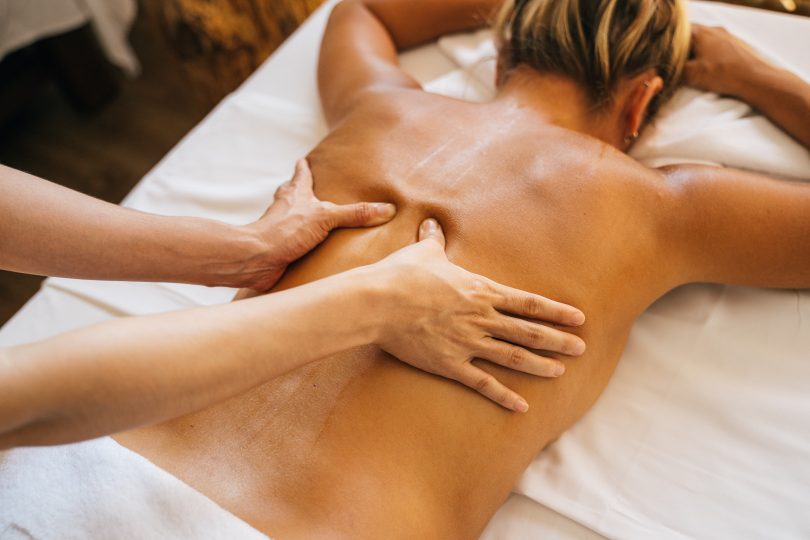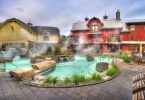Visiting Thermal Spas is something I have been doing with my husband for over 20 years… damn am I that old? We started when we were first dating and he wanted to impress me with his ‘Finnish heritage’ and took me to the Polar Bear club north of Montreal. To his surprise I matched him for every hot sauna, steamy pause and dip in icy rivers.
To be honest, I had no idea what I was doing and would just follow his lead. Into the steam room, then the sauna, roll in the snow or jump in a cold pool, I happily joined in. It was only a few years that some places started posting their recommended ‘how-to’ to maximize your experience.
What’s the Point of a Thermal Spa?
Basically a thermal spa is where you spend time at different ‘stations’ and experience temperature changes to open the pores and encourage perspiration. There are therapeutic effects from perspiration and it’s a routine people have been doing for thousands of years to boost the body’s natural defenses and relieve stress, coughs and colds. It cleans and rejuvenates the skin, boosts skin cells and promotes healthy cells.
View this post on Instagram
Thermal Spas ARE Hygge
Spa Experience Facilities
- Sauna: A dry heat treatment in a wood-lined room with a temperature reaching 90 degrees Celsius, designed to induce perspiration in order to cleanse the body of impurities.
- Some spas (like Spa Finlandais in Rosemere, QC,) offers an enhanced ‘Temazcal Experience’. The Temazcal Experience is a multi-sensory experience based on an ancient Aztec ceremony inspired by 4 elements: water, earth, air, and fire. During the session, the center of the room releases heat and steam to allow the body to open the pores and relax muscle tension. Each session lasts 15 minutes and can accommodate a maximum of 12 people. Overall, the Temazcal Experience can be defined as a different way to enjoy a sauna with equivalent benefits for the body.
- Russian Sauna: Also called banya: it has the peculiarity of being halfway between a dry sauna and a steam bath. The brick stove that heats the room is sprinkled with water, releasing a dry, light steam, and a soothing mist is diffused from the ceiling at regular intervals. Combining stone, wood and ceramic, its cold water well and its delicate mist, the Russian Sauna is a unique and thrilling stopover.
- Steam room: A room created when a water-filled generator pumps steam into an enclosed space so there is moisture in the air. Sitting in a steam room is shown to improve relaxation and relive some medial conditions, while improving circulation which leads to lowered blood pressure and a healthier heart. My favorite are the Eucalyptus steam baths.
- Many spas have a Hamman Roman thermal bath that thanks to its humid steam and warm ambiance, helps dilate the pores and cleanse the skin, and also relaxes the muscles and decongests the respiratory tract. Relaxation guaranteed.
- Exfoliation Stations: An exfoliation room is great after a steam bath. A fine rain and treatment of salt (usually dispensed from a large vending machine), regenerates your skin.
- Hydrotherapy pool (hottub): Multiple jets working on different muscle groups to pummel away any stress and fatigue from the body. Although not common 20 years ago, most spas now offer thermal waterfalls or specialty chairs in their hottubs.
- River dip: This is a very popular aspect in winter.
- Plunge pool: A vital part of the thermal spa experience is alternating heat treatments with a brief immersion in the traditional Plunge Pool. Each dip in the icy pool will improve circulation by cooling the body; this can also improve cardiovascular health. This is great for people that are a bit weary of dipping in a river or fearful of icy rocks.
- Monsoon Showers: Several jets release scented water, creating contrasting shower experiences. These jets range from a warm tropical downpour to cool water, releasing a fine Scotch mist.
- Relaxation lounges: An oasis of calm. This quiet sanctuary is a designated area for pure relaxation while taking delight in complimentary infused water and fresh fruit. Some spas offer solariums, zero-gravity pavilions, terraces, hammocks and everyone I have been to always has multiple firepits.
- At Spa LaFinlandais check out their Himalayan Lounge where the walls are made of blocks of pink Himalayan salt, which has beneficial properties for the respiratory system. With the changing colours of the salt blocks, its warm fireplace and natural light, the Himalayan Lounge’s enchanting decor invites you to relax both body and mind.
- Hot rooms (Turkish baths): Based on a system that is thousands of years old, these hot, dry air rooms vary from moderate to intense heats. Every 10 minutes, transition from the Tepidarium (warm room) to the Caldarium (hot room) to the Laconium (hottest room) to relax the muscles and relieve the pain of rheumatism.
- Massages as well as facial and other body treatments.
View this post on Instagram
How do you ‘do’ a Thermal Spa
Here is a guide to the steps to follow for an ideal thermotherapy session. Allow yourself 2 hours to complete the whole cycle. Feel free to repeat steps 2 to 4 and 6 to 8 twice.
- 1. Start with a shower.
- 2. Continue with a stop at a dry saunas, for 5 to 15 minutes.
- 3. Take a quick dip in cold water, in the Arctic Bath or under a cold shower.
- 4. Relax in one of the numerous lounging areas for 10 to 15 minutes (or more!).
- 5. Enjoy the contrast between the hot water and the freshness of the ambient air in a thermal bath, for 5 to 10 minutes.
- 6. Then try a steam bath, in the hammam or Russian sauna, for 5 to 15 minutes.
- 7. Immerse yourself briefly in cold water again.
- 8. Enjoy relaxation and quietness in a lounge area.
Spa Etiquette
How to have the best Thermal Spa Experience (a.k.a. my lessons learned)
After all our visits here are a few things we have learned to help any beginner guide their experience.
- The obvious tip is bring a swimsuit and flipflops! Some places have flipflops on sale and even swim suits, but it’s never a guarantee that they will, or that they will have your size.
- Most places will provide you with a water if you are getting a package or buy it, but if your environmentally conscious, bring your refillable water bottle. Many people do not realize how dehydrating the spa experience can be.
- If you want to get the best bang for your buck, book a massage. Most places will allow you free access to the spa if you book a massage. The added bonus is that you can likely claim the massage with your insurance, so it’s like a free visit. Make sure you tip you masseuse, especially if you are claiming it on insurance – don’t be cheap!
- If you are able to, visit in the off-time. We went on a Sunday night in late fall and it was amazing!
Do you have any tips to share for a thermal spa experience? Let us know in the comments below.








